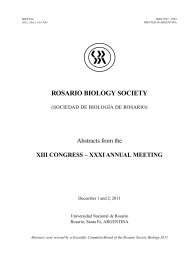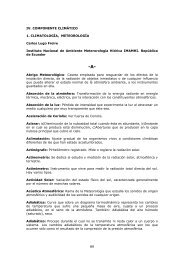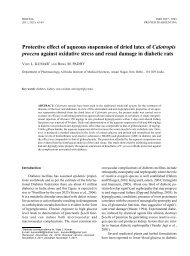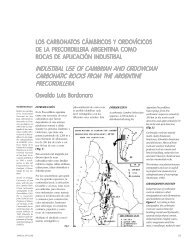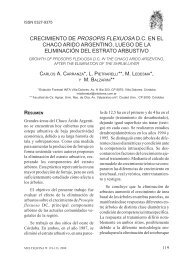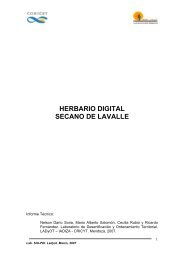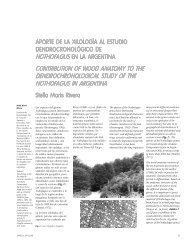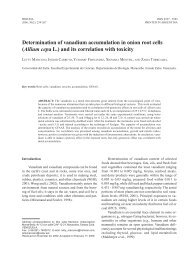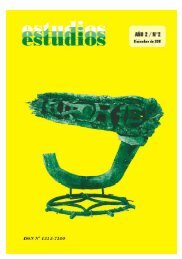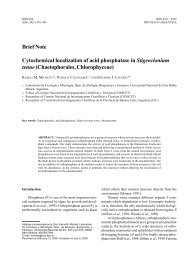XXII Annual Scientific Meeting, Tucuman Biology Society ...
XXII Annual Scientific Meeting, Tucuman Biology Society ...
XXII Annual Scientific Meeting, Tucuman Biology Society ...
Create successful ePaper yourself
Turn your PDF publications into a flip-book with our unique Google optimized e-Paper software.
208 ABSTRACTS<br />
169.<br />
CONTENT OF N-P-K IN DIFFERENT COMPONENTS<br />
MORFOLOGICS FROM STRAWBERRY PLANTS cv. SELVA<br />
IN CULTURE OF 1 st AND 2 nd YEAR IN TAFÍ DEL VALLE,<br />
TUCUMÁN, ARGENTINA<br />
Brandán de Antoni E, Nader C, Fernández R, Antoni H, Hernández<br />
C, Villagra E, Jaldo H.<br />
Fac. de Agron. y Zoot. UNT. Av. Roca 1900. (4000) Tucumán, Argentina.<br />
E-mail: ezbrantoni47@yahoo.com.ar<br />
The objective of the work was to determine the content of NPK in<br />
plants of strawberry, cv. Selva of 1 st and 2 nd year cultivated in 2003/<br />
04, in Tafí del Valle at 2000 m.o.s.l. Fertilization was: 50, 20, 100<br />
UF of NPK, in culture of 1 st year and 110, 45 and 220 of UFN-P-K<br />
in the 2 nd year. It was determined the content of NPK % in fruits,<br />
leaves and petioles in plants of 1 st and 2 nd year in March of 2005.<br />
ANVA and Test of Tukey in plant and correlation of Pearson of<br />
NPK % in fruit took place. Significant differences in 2 nd year with<br />
respect to 1º year of N in fruit of 1,4 and 1.2; leaves of 2,4 and 2.3;<br />
and petioles of 0,9 and 0.7; P in: petioles of 0,19 and 0.18; K in:<br />
petioles of 2,8 and 2,3, respectively, and significant differences in<br />
culture of 1 st year with respect to 2 nd year of P in: fruit of 0,2489<br />
and 0.24; K in: fruit 2,1 and 1,7 and leaves of 1,9 and 1,7, respectively,<br />
were founded; and negative correlation in fruit between P<br />
and N (-0.5736), K and N (-0,8277); and positive correlation between<br />
K and P (0.4976) were founded. Its results suggest it is necessary<br />
to adjust the fertilizers according the smaller fruits demand<br />
of P and K% in the 1 st year.<br />
170.<br />
EVALUATION OF YIELDS AND ABSORPTION OF N-P-K<br />
IN TUBER (Solanum tuberosum L. Spunta) SEED IN TAFÍ DEL<br />
VALLE, TUCUMÁN, ARGENTINA<br />
Brandán de Antoni E, Villagra E, Hernández C, Fernández R, Torres<br />
C, Antoni HJ, Carrasco MP.<br />
Fac. de Agron. y Zoot. UNT. Av. Roca 1900. (4000) Tucumán, Argentina.<br />
E-mail: evillagra@faz.unt.edu.ar<br />
The object of the trial was to evaluate yields and absorption of<br />
NPK by seed potato, cv. Spunta, in Tafí del Valle, in 2004/05. The<br />
experimental design was Blocks at random with 6 treatments:<br />
T1.Control. T2. 100 Units of fertilization of N/ha. T3.100 UFN+90<br />
UFP/ha. T4.100 UFN+150 UFK/ha. T5.100 UFN+90 UFP/ha+150<br />
UFK/ha. T6. 130 UFN+160 UFP/ha, and 5 repetitions. The ANVA<br />
and LSD in tuber yield, Test of Tukey in NPK in tubers and correlation<br />
between production of seed potato and NPK in tubers were<br />
realized. Differences in yield of tuber were detected between<br />
T6(22,140) and T5(20,164) with respect to T1(12,404) kg/plot.<br />
Significant differences in content of N were detected between:<br />
T6(1,6), T3(1,4), T2(1,4) and T4(1,4) with T5(1.3) and T1(1.1);<br />
between T2(1,4), T5(1,3) and T5(1,3) with T1(1,1); in content of P<br />
between T2 (0,26), T3 (0,26), T5 (0,26) T6 (0,26) and T1 (0,24)<br />
with T1 (0.23). There were no differences in K in tubers. Positive<br />
correlation between yields with N (0.3233) and P (0.1338) and low<br />
correlation of K (0.0648) in tubers were found. Its results suggest<br />
it is necessary to realize adjustment fertilizer according the absorption<br />
and accumulation of NPK by the tubers seed.<br />
BIOCELL 30(1), 2006<br />
171.<br />
RELATIONSHIP BETWEEN LOW TEMPERATURES AND<br />
TISSUE DAMAGE IN LEMON (Citrus limon L.)<br />
Amado ME, Rodríguez Rey JA, Flores Álzaga LD, Pardo PA,<br />
Martínez ER, Díaz JV, Delgado N, Orell EE.<br />
Fac. Agr. y Zoot. UNT. Tucumán. E-mail: meamado@faz.unt.edu.ar<br />
Lemon has become very important crop in Tucumán in the last<br />
years. This province presents big thermic variations with frequent<br />
Autumn-Winter frosts. At -2°C flowers, at -3°C leaves and -9°C<br />
woody tissues are damaged. Damage is related with the duration of<br />
low temperatures. The objective of this study was to evaluate tissue<br />
damage caused by low temperatures in different top sectors of<br />
lemon plants. It was worked in El Manantial with Eureka variety<br />
top and Citrange Troyer rootstock trees. The low temperature incidence<br />
on North and South top sectors was evaluated. The mean<br />
minimum registered was 3°C. The cellular flux conductivity of leave<br />
tissue was determined as Dexter (1932) modified by Amado and<br />
R. Rey (1984). In each sampling date, 10 samples were incubated<br />
at 25°C, 15 hs. (control) and 10 treated at -10°C, 2 hs., then incubated<br />
the same as control. Tissue damage index (T.I.I., Singh and<br />
Kanwar, 1978) was calculated: T.I.I=Control Conductivity (25°C)/<br />
Treatment Conductivity (-10°C). Conductivity determination of the<br />
cellular flux of congealed and uncongealed cells permits to evaluate<br />
the low temperatures damage to the membrane system functioning.<br />
Results show greater tissue damage at leave level at top<br />
South sector than at the North one owing to the cold front advance<br />
from that orientation.<br />
172.<br />
EFFECT OF THE THERMIC FACTOR IN THE REPRODUC-<br />
TIVE DEVELOPMENT OF PEPPER CROP<br />
Amado ME, Budeguer RF, Flores Álzaga LD, Pardo PA, Martínez<br />
ER, Alderete G.<br />
Fac. Agr. y Zoot. UNT. Tucumán. E-mail: meamado@faz.unt.edu.ar<br />
The pepper production in greenhouse constitutes an important activity<br />
for Tucumán province (Argentina). Pepper is a species with<br />
high sensibility to low temperatures, manifesting a growth detention<br />
at 10°C and minor flower coagulation at 18°C. The objective<br />
of this study was to evaluate the development of the pepper crop in<br />
a determined thermic cycle for the 2005 year employing the minimum<br />
temperatures occurred in the greenhouse. It was worked from<br />
last May to middle September in the Centro de Experimentación<br />
Adaptativa Lules (CEAL) dependent of the Instituto Nacional de<br />
Tecnología Agropecuaria (INTA) located at San Isidro de Lules<br />
(Tucumán province). It was used the Margarita hybrid. The implantation<br />
was made to a distance of 40 cm between plants and 120<br />
cm between lines. Evaluations were made from May 31 st to September<br />
19 th consisting on the extraction of three entire plants. Fresh<br />
weight, dry weight and number of flowers per plant were determined<br />
according to the methodology of evaluation and analysis of<br />
the growth. Results show a decreasing of the number and dry weight<br />
of flowers in an 80% when minimum greenhouse temperature decreased<br />
from 10°C to 3°C which indicates minor flower coagulated<br />
and low yield of the pepper crop at cooling temperatures.



